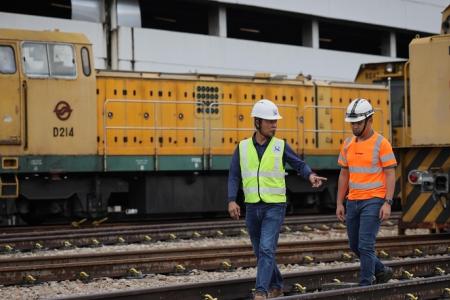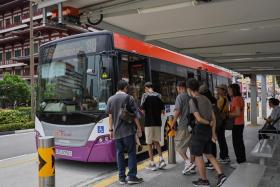Checks on repaired EWL track carried out nightly
Visual inspections of newly replaced sections of rail on the East-West Line (EWL) between Jurong East and Buona Vista MRT stations are being done every night to ensure no further issues or defects arise, said a senior engineer at rail operator SMRT.
Speaking to the media on Oct 1, Mr Shazni Jaffar, 33, who helped oversee some of the rail replacement work along the four-station stretch of the EWL that was disrupted from Sept 25 to 30, said the more frequent inspections will continue until the team is confident about the stability of the repairs.
Inspections of the track will then return to the usual weekly schedule. When asked, SMRT was unable to provide an estimate on when this will happen.
In one of the worst disruptions to Singapore’s MRT system in its 37-year history, train services along the EWL between Jurong East and Buona Vista were crippled for six days.
This was due to track damage so severe it shocked railway engineers put in charge of the recovery work.
“My immediate reaction was ‘oh my god’, because I have not seen any rail break in that manner,” said the Land Transport Authority’s (LTA) deputy director for trackwork, Mr Zailani Mohamed Idris, 60.
The 25-year industry veteran said the pattern of the rail fractures was unusual, and different from the cleaner breaks usually seen as a result of wear and tear.
For Mr Shazni, this was the first major MRT disruption he has been involved in since joining the rail industry five years ago. “I was shocked,” he told reporters. “When I saw the extent of the damage, I knew we definitely would not be able to fix it in one night.”
Mr Shazni and Mr Zailani were among the more than 800 workers who were mobilised between Sept 25 and Sept 30 to carry out repairs on the rails, power cables and other trackside equipment damaged by a faulty train returning to Ulu Pandan Depot on Sept 25.
Across the six-day disruption, SMRT deployed about 500 workers, including its entire track maintenance workforce. They worked around the clock in two shifts, each lasting 12 hours.
LTA, meanwhile, pulled in 300 workers from external contractors involved in other active track-related projects, including the upcoming Jurong Region Line and Circle Line Stage 6 extension. These workers were put on three shifts of about eight to 10 hours each.
These 800 workers were in addition to the 620 ground staff from LTA, SMRT, transport operators SBS Transit and Tower Transit, and police officers, who were activated to manage the crowds during the morning peak period on Sept 26 and 27.
At its peak, there were about 100 workers on the viaducts between Jurong East and Buona Vista focused solely on replacing rail segments that had cracked or chipped.
The track damage was caused by a first-generation Kawasaki Heavy Industries train, which suffered a fault near Clementi station at about 9am on Sept 25.
While the train was being withdrawn to Ulu Pandan Depot, a part of its undercarriage went off the rails, leaving a 2.55km trail of destruction in its wake and causing a power trip that caused other trains to stall.
Mr Zailani said he learnt about the disruption from the news and received a message from his boss shortly after, telling him to stand by in case he needed to support the recovery effort.
“At that time, I did not realise that there were rail breaks. It was just what was reported - that there was a power fault and a stalled train,” he said.
Similarly, Mr Shazni did not know the extent of the disruption until he was called into a meeting on Sept 25 evening and saw the initial assessments.
Given the short notice and scale of the damage, SMRT did not have enough resources to carry out all the repairs, and LTA stepped in to help, Mr Zailani said.
He recalled being summoned to LTA’s operations centre at its headquarters in Hampshire Road at about 9.30am on Sept 26. That was when he started to mobilise support from LTA’s contractors, and worked with SMRT to devise a strategy to replace the broken rails.
New rail segments were delivered to the affected stretch in the early hours of Sept 27 during engineering hours, before cutting and welding work began at about 8am that day.
Based on the resources and labour available, it was decided that LTA and its contractors would carry out the bulk of the rail replacements.
One reason was that SMRT’s rail replacements typically take place at night, and this was the first time they were carrying out such works in the day. Additionally, SMRT needed labour to carry out other repair and recovery works. There was also a need to ensure that both sides had sufficient tools and materials such as welding kits.
With this in mind, the work was split so that LTA and its contractors replaced the damaged rail sections closer to Dover station with new rail segments delivered from Changi Depot, while SMRT replaced those nearer Clementi station, with new rail segments taken there from Ulu Pandan Depot.
Mr Shazni said this ensured that the supply of new rails could be replenished from both ends of the rail line, allowing the repairs to be completed faster.
Mr Shazni and Mr Zailani cited several challenges that made the recovery effort tougher than usual.
The weather was one issue, and tents were set up to shelter workers given the task of welding the replacement rails to the existing tracks, Mr Zailani said. This is because exposure to rain leads to poor-quality welds that are likely to fail.
“The viaducts are in an open environment, making lightning hazards a risk for workers... In addition, the rails and sleepers will be wet from the rain, creating a slippery work environment,” he added.
When it was not raining, the sweltering heat hampered rail replacement. Besides raising the risk of workers getting fatigued and suffering heat exhaustion, Mr Shazni said rail cutting was especially challenging between 10am and 3pm, as the heat would cause the rails to expand and rail saws to get stuck.
With the welding equipment generating heat that can go up to 2,000 deg C, Mr Zailani said it is also not easy to perform such work in hot weather.
Added to that was the already-limited space to manoeuvre on the rail viaducts. The scale of the track damage piled on further complications.
During regular rail replacement works, engineering vehicles can usually go to the exact location on the track to drop off new rail segments.
In this case, because the rails were damaged, and the affected area had no power, the engineering vehicles had to stop at the nearest station - either Dover or Clementi - and unload the new rail segments there.
Workers then had to load the rail segments, weighing about a tonne each, onto a jig and push the jig to the various rail replacement locations. The farthest one was 600m to 700m from Dover station. Each jig needed about eight workers to push, with each delivery taking 30 to 45 minutes, depending on the distance.
Initially, 34 rail fractures were discovered between Clementi and Dover stations and the calculations were that the rail replacement work would be completed in two days, and train service could be restored on Sept 30.
But stress tests on Sept 28 uncovered 12 new cracks, and full restoration of train services was pushed to Oct 1.
Said Mr Shazni: “We are very grateful for the guys on the ground... They sacrificed their weekend and their time with their families to make sure the trains resumed service as soon as we could.”
He was also thankful that his family understood why he had to spend more time away from home.
Get The New Paper on your phone with the free TNP app. Download from the Apple App Store or Google Play Store now


